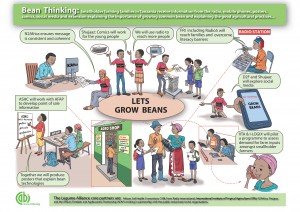Graphics and research point the way ahead…
Duncan Sones writes:
The Legume Alliance is trying to persuade farmers to change their bean growing habits and a series of partners are working together to make this a reality. The changes we are promoting include using seeds of improved varieties of common bean and applying fertilizer along with the usual good agricultural practices.
Two of our associates provided value contributions to help make this campaign effective. First, artist Simon Ndonye provided produced an info-graphic that shows the entire campaign at a glance (see below). This beautifully illustrates how different media will reach different members of a smallholder farming family. The man of the house mainly seeing posters in the agrodealers, the children reading the Shujaaz comic and the woman hearing the radio and receiving the SMS messages.
What this diagram does not show is how we will be addressing measurement and evaluation of the campaign. We are pleased to share that we are working with the Royal Tropical Institute (KIT) to help us work out what has, or has not, worked. KIT is busy building a toolkit of measurement tools. First they are thinking about proto-type testing materials (which will be developed at the write-shop next week) and then they will look at tools to measure changes in knowledge and trailing of legume technologies.
Ahead of this Wouter Kleijn from KIT has been working with Peter Shao from Africa Fertilizer and Agribusiness Partnership (AFAP) to produce an information needs assessment. The draft report for Tanzania arrived this week, and once it has been finalised it will be shared on this website.
Next week in Arusha we will be working with around 30 experts on legumes and/or communications to create campaign materials. Specifically we will be looking to produce materials for extension workers, point-of-sale material for agrodelaers and SMS and voice telephony messages. So the information needs assessment came at a very good time. In this blog I thought it would be interesting to share what the farmers said.
Summary of the information issues raised by smallholder farmers in Tanzania:
* Farmers like feedback mechanisms – such as names of individuals and contact details. Even if they did not use them they like to know who to contact if a problem occurred.
* Information to farmers should be specific – relate to one crop specific and a specifc agro-ecological zones and provide information on which products to use, how to apply, at what dosage, where to buy these, etc.
* Information should be comprehensive yet concise. Texts for farmers should be reduced to the minimum supported by visual information. It should cover all stages of the crop production process from land preparation to post-harvest management.
* Information on new seed varieties, fertilizer and pesticides was also considered to be important . Input provision is constantly changing as new products arise, yet information is lagging behind. It is crucial that information is both specific and practical, and ready to use, as mentioned. For seed varieties, this means information on proper spacing and weeding practices for example, but also information on what other inputs (e.g. fertilizers, pesticides) to use. For fertilizers and pesticides, clear instructions on which products to use, the dosage for application, and timing of application is necessary and how this relates to other agronomic practices.
* Crop diseases and pests such as the maize lethal necrosis disease and the tomato leafminer (Tuta absoluta) are disastrous for farmers. Again, information on these diseases should be practical. Farmers (but also intermediaries) want to have more details on the symptoms/signs of these diseases and pests, which product to use and at what dosage and time. Information on the dosage of pesticides is often put in hectares, but should be converted to local measures.
* Sometimes difficult words in Kiswahili are used instead of more commonly accepted words in Kiswahili or English. This can be confusing for farmers. Hence appropriate translation to common language is necessary. For example the word “viatilifu”, a new word for herbicides, fungicides and insecticides, was used quite regularly in some materials, yet incomprehensible for farmers.
In a future blog I will tell you how we got on at the write-shop and how useful this list was in shaping materials.
Duncan Sones is a CABI associate who has been working on ASHC since 2011.

